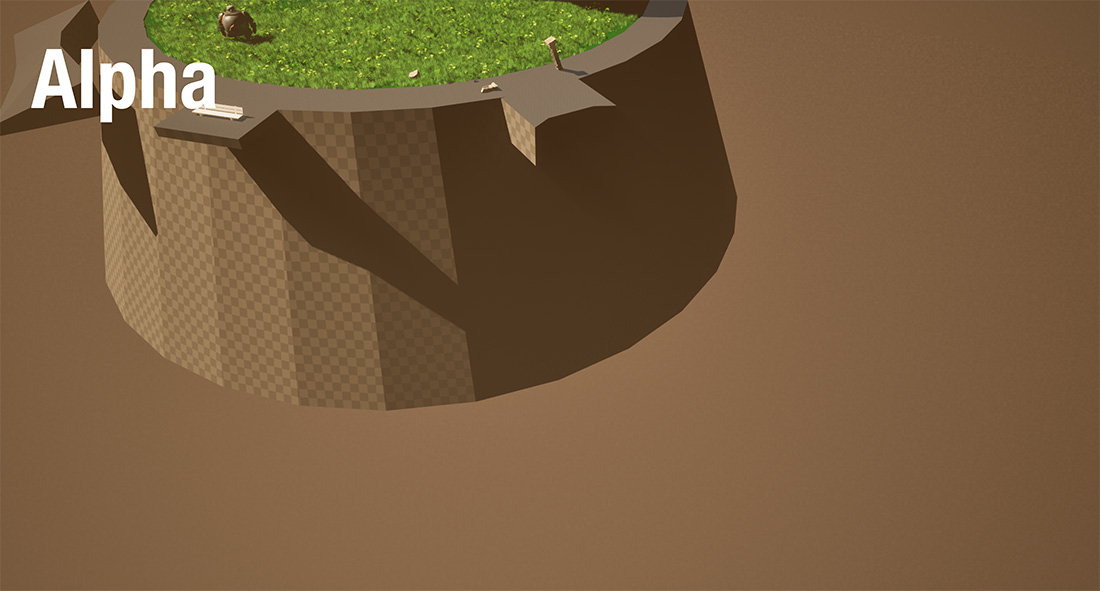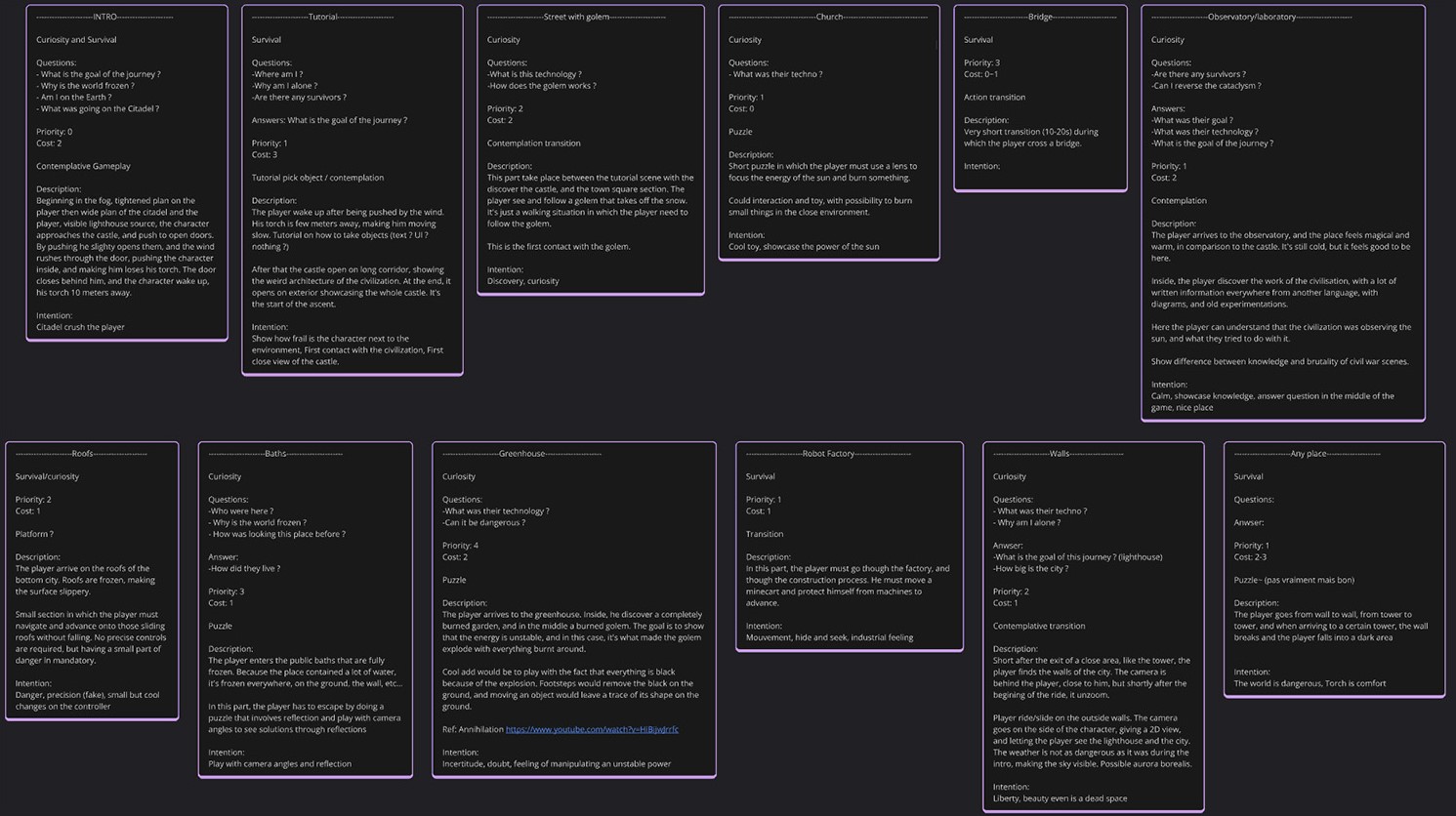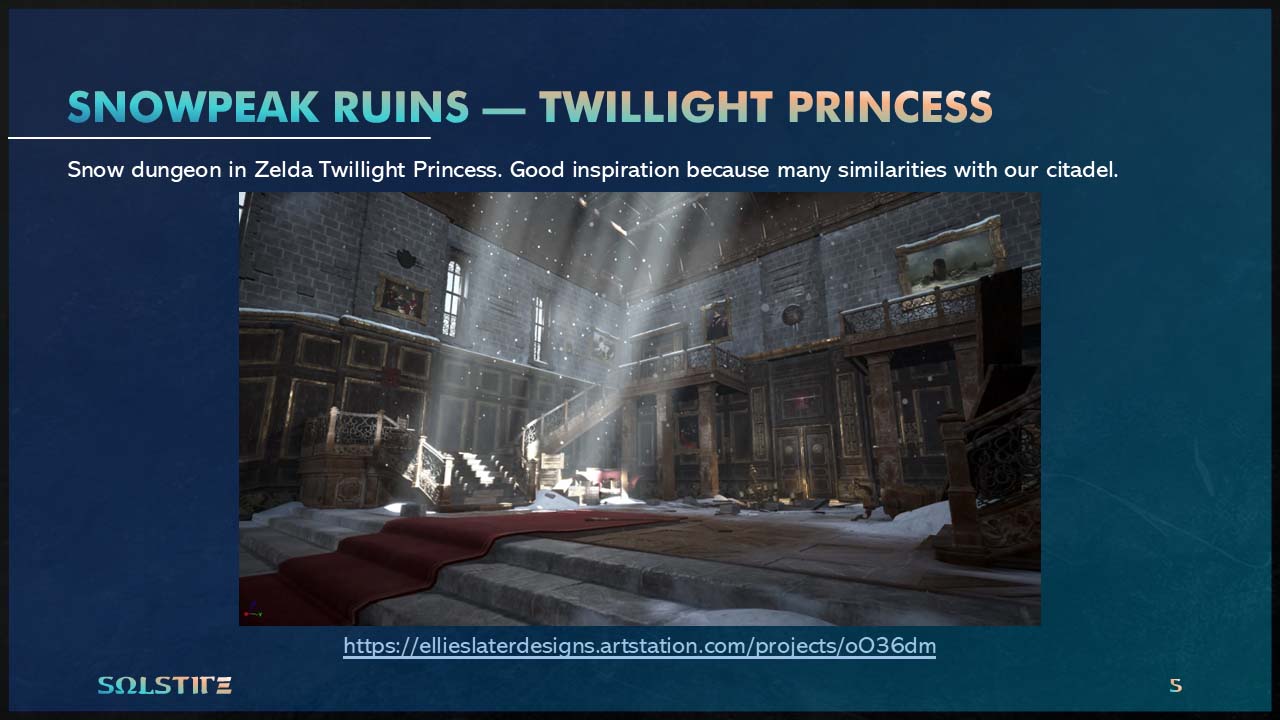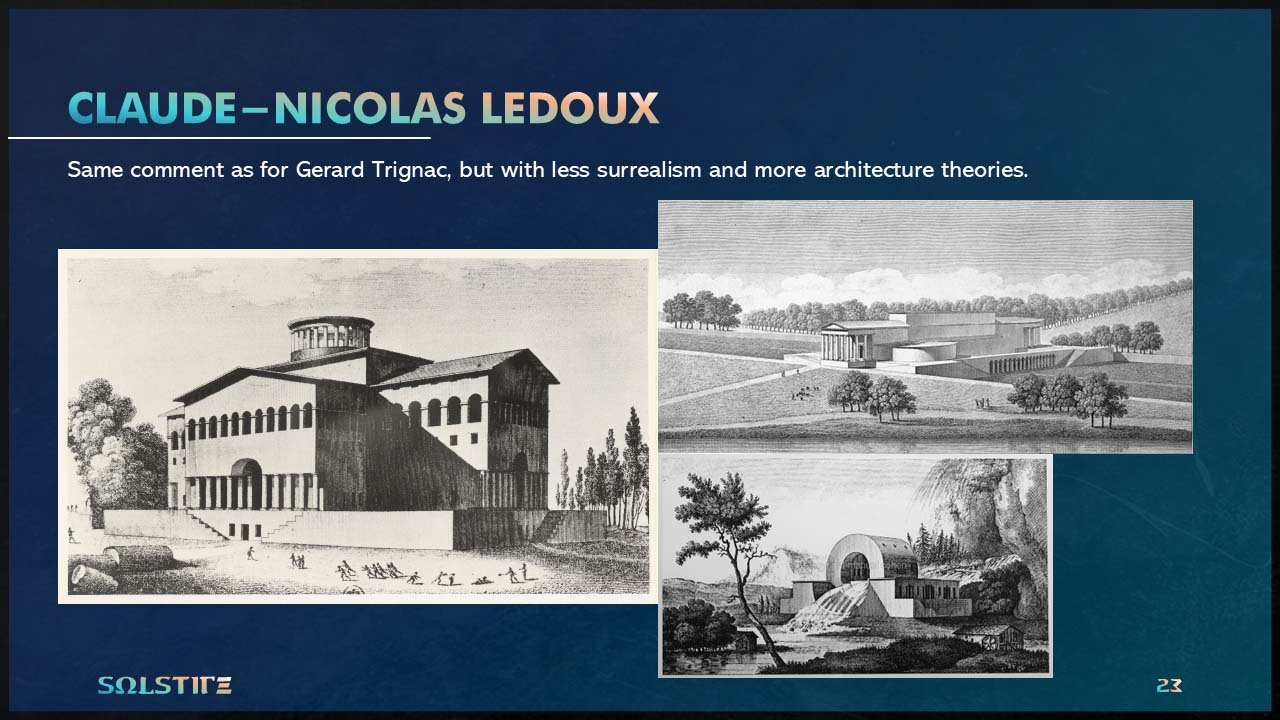Level design for a cinematic game:
«Solstice»
Project breakdown
• Team project with six Game Designers, three Game Artists and two Sound Designers
• Eight production months
• Created using Unreal Engine 5.3
• Focus on scenery and camera shots
Pitch, feature and pillars
To get a better idea of what it's all about.
Solstice is a narrative adventure game, with an emphasis on cinematography.
You play as the wanderer, a small character who must navigate a frozen citadel, solve environmental puzzles and traverse action sequences to reach the top of a mysterious Lighthouse.
Camera as main feature
Solstice's main feature is how its cameras work. All the game's cameras have been designed and placed by hand by the Level Designers. The player has no control over the camera angles; it's the Designers who decide at any given moment how to frame the action and what behavior the camera adopts.
Level Design pillars
• Create the feeling of ascension
• A citadel that tells the story of its civilization
• Arouse curiosity
Our main references for Level Design
Pitch, feature and pillars
To get a better idea of what it's all about.
Solstice is a narrative adventure game, with an emphasis on cinematography.
You play as the wanderer, a small character who must navigate a frozen citadel, solve environmental puzzles and traverse action sequences to reach the top of a mysterious Lighthouse.
Camera as main feature
Solstice's main feature is how its cameras work. All the game's cameras have been designed and placed by hand by the Level Designers. The player has no control over the camera angles; it's the Designers who decide at any given moment how to frame the action and what behavior the camera adopts.
Level Design pillars
• Create the feeling of ascension
• A citadel that tells the story of its civilization
• Arouse curiosity
Our main references for Level Design
The Underground
With its ominous and foggy atmosphere.
The Underground level is quite unique in its proposition within the game. As the player explores the snow-covered city during the first half of the game, he stumbles into the citadel's underground world.
The highlight of the level is the fight against the chained Golem. At first, it's asleep, but as the player approaches, it wakes up and the fight begins. It can destroy the arena's debris with its blows, while the player must navigate around obstacles.
The goal here was to contrast with the fairytale atmosphere of the city. You can't see much in the dark, the fog further reduces visibility, and you have to navigate through what appears to be a dumping ground for old Golems.
Contrast the bright, blue ambiance of the streets with a very dark zone
This level contributes to the narrative development of the game's main story. I created a space and set up a camera specifically to highlight one of the frescoes explaining the story of the citadel's golden age, with the rise of technology.
There's also a little narration within the level, with the teasing and then the discovery of a giant dismantled Golem. At first, the player gets a glimpse of its arm, then later a camera shot of its entire body.
I worked not only on the level layout and cameras but also on the lighting, the fog, and the Level Art by placing all the props. Here are some comparisons between the Alpha and Gold atmospheres.
The Underground
With its ominous and foggy atmosphere.
The Underground level is quite unique in its proposition within the game. As the player explores the snow-covered city during the first half of the game, he stumbles into the citadel's underground world.
The highlight of the level is the fight against the chained Golem. At first, it's asleep, but as the player approaches, it wakes up and the fight begins. It can destroy the arena's debris with its blows, while the player must navigate around obstacles.
The goal here was to contrast with the fairytale atmosphere of the city. You can't see much in the dark, the fog further reduces visibility, and you have to navigate through what appears to be a dumping ground for old Golems.
Contrast the bright, blue ambiance of the streets with a very dark zone
This level contributes to the narrative development of the game's main story. I created a space and set up a camera specifically to highlight one of the frescoes explaining the story of the citadel's golden age, with the rise of technology.
There's also a little narration within the level, with the teasing and then the discovery of a giant dismantled Golem. At first, the player gets a glimpse of its arm, then later a camera shot of its entire body.
I worked not only on the level layout and cameras but also on the lighting, the fog, and the Level Art by placing all the props. Here are some comparisons between the Alpha and Gold atmospheres.
The Garden
With its warm colors and grass that blows in the wind.
The Garden is another level that contrasts sharply with the cold atmosphere of the entire game. It's the last area of the game, just before reaching the top of the Lighthouse. The warmth radiated by the tower allows a small wild garden to survive, where all other areas are cold and dead.
The central feature of the Garden is the narrative fresco at the base of the Lighthouse. All the cameras are focused on it to really highlight it. It tells the story of the fall of civilization, which then led to the Ice Age.
With its red sky and warm ambience, the Garden's purpose was to contrast with the two long sections of dark, cramped interiors the player had just traversed, including the Underground.
When the player enters the level, he begins in the clouds without knowing where he is. I set up a camera shot emerging from the clouds to reveal the Garden.
After the Garden, there's the long climb up to the Lighthouse. This sequence offers views of the Garden, and symbolizes the last stretch before arriving at the end. There's a real change of atmosphere during the ascent, the aim being to create apprehension in the player, who doesn't yet know what awaits him after his journey.
Not only did I work on the layout, of course I designed and set up all the cameras, but I also took part in creating the atmosphere, with the grass, the positioning of assets, the fog and the lighting. Here are some comparisons between the Alpha and Gold atmospheres.
The Garden
With its warm colors and grass that blows in the wind.
The Garden is another level that contrasts sharply with the cold atmosphere of the entire game. It's the last area of the game, just before reaching the top of the Lighthouse. The warmth radiated by the tower allows a small wild garden to survive, where all other areas are cold and dead.
The central feature of the Garden is the narrative fresco at the base of the Lighthouse. All the cameras are focused on it to really highlight it. It tells the story of the fall of civilization, which then led to the Ice Age.
With its red sky and warm ambience, the Garden's purpose was to contrast with the two long sections of dark, cramped interiors the player had just traversed, including the Underground.
When the player enters the level, he begins in the clouds without knowing where he is. I set up a camera shot emerging from the clouds to reveal the Garden.
After the Garden, there's the long climb up to the Lighthouse. This sequence offers views of the Garden, and symbolizes the last stretch before arriving at the end. There's a real change of atmosphere during the ascent, the aim being to create apprehension in the player, who doesn't yet know what awaits him after his journey.
Not only did I work on the layout, of course I designed and set up all the cameras, but I also took part in creating the atmosphere, with the grass, the positioning of assets, the fog and the lighting. Here are some comparisons between the Alpha and Gold atmospheres.
Lost Level: The Cathedral
Praise the sun.
The Cathedral is the first of two levels I worked on that were cut to reduce the artistic scope. It was one of the game's two major levels. It was situated towards the end of the first half of the game and marked the transition from the lower town to the intellectual districts. It's close to being playable, the design and intentions were already there.
The Cathedral was supposed to contain an environmental puzzle. In it, the player had to find a lens under the snow, place it, and then move mirrors on a pedestal. Finally, the player would use the lens to concentrate the heat from his lantern and bounce it off the mirrors to the ice blocking the exit, causing it to melt.
The Cathedral's narrative role was to express the sun-worship of the citadel's civilization. It was to contain a large fresco on the floor showing the link between the city and the star. It was also to be understood as a place where citizens performed religious ceremonies related to the sun.
Lost Level: The Cathedral
Praise the sun.
The Cathedral is the first of two levels I worked on that were cut to reduce the artistic scope. It was one of the game's two major levels. It was situated towards the end of the first half of the game and marked the transition from the lower town to the intellectual districts. It's close to being playable, the design and intentions were already there.
The Cathedral was supposed to contain an environmental puzzle. In it, the player had to find a lens under the snow, place it, and then move mirrors on a pedestal. Finally, the player would use the lens to concentrate the heat from his lantern and bounce it off the mirrors to the ice blocking the exit, causing it to melt.
The Cathedral's narrative role was to express the sun-worship of the citadel's civilization. It was to contain a large fresco on the floor showing the link between the city and the star. It was also to be understood as a place where citizens performed religious ceremonies related to the sun.
Lost Level: The Roofs
Challenges the player's movements.
The Roofs is the second level I worked on that was cut. After the Cathedral, the player moved on to the Roofs level, before reaching the Bridge. This level challenged the player's movements, as he had to navigate from roof to roof on slippery surfaces. It's only geometry and Level Design intentions, nothing playable.
Roofs were a transitional zone, not intended to take over other, more important spaces. It's a space that doesn't cost very much in assets, and it allowed for gameplay diversity with the game's only movement challenge. The cameras could have offered different views of the city, showing old areas explored and the progression to the Lighthouse.
Lost Level: The Roofs
Challenges the player's movements.
The Roofs is the second level I worked on that was cut. After the Cathedral, the player moved on to the Roofs level, before reaching the Bridge. This level challenged the player's movements, as he had to navigate from roof to roof on slippery surfaces. It's only geometry and Level Design intentions, nothing playable.
Roofs were a transitional zone, not intended to take over other, more important spaces. It's a space that doesn't cost very much in assets, and it allowed for gameplay diversity with the game's only movement challenge. The cameras could have offered different views of the city, showing old areas explored and the progression to the Lighthouse.
The camera system
Tools for creating great camera shots.
As a Level Designer, I was in charge of all camera shots within my levels. To do this, I used tools developed by the Technical Designers to place cameras and set their behavior. To be clear, I didn't work on the development of the tool itself, but I used it a lot.
The two types of camera I'm about to talk about share much the same parameters. So the first thing to do is to set all the start and end parameters, such as distance, rotation, offset, lens aperture, and others, according to the desired result.
The Dolly Camera
When the player enters the trigger box, the Dolly Camera follows and applies effects according to the player's position in relation to the movement spline. For example, if the player is at the beginning of the spline, the camera applies the effects with the start values.
Example of Dolly Cameras in the Underground
The Trail Camera
The Trail Camera behaves very similarly to the Dolly Camera. What sets it apart is the way it manages the camera's position. Here, the camera does not follow the player, but follows a predefined trail. Like the Dolly, the camera's position and the effects applied to the camera depend on the player's position on the movement spline.
Example of Trail Camera in the Garden
Case study: The Garden
The camera shots at the Garden aimed to highlight the fresco at its center. I had carried out several tests with Trail Cameras that went all the way around the space; it didn't work out too well.
I therefore divided the space into three Dolly Cameras, which I transitioned to each other. This allowed me to manage how much I wanted to blur the background in each tier, and above all to make more subtle camera movements. For example, Dolly 3 shows the staircase that leads to the end of the level.
The camera system
Tools for creating great camera shots.
As a Level Designer, I was in charge of all camera shots within my levels. To do this, I used tools developed by the Technical Designers to place cameras and set their behavior. To be clear, I didn't work on the development of the tool itself, but I used it a lot.
The two types of camera I'm about to talk about share much the same parameters. So the first thing to do is to set all the start and end parameters, such as distance, rotation, offset, lens aperture, and others, according to the desired result.
The Dolly Camera
When the player enters the trigger box, the Dolly Camera follows and applies effects according to the player's position in relation to the movement spline. For example, if the player is at the beginning of the spline, the camera applies the effects with the start values.
Example of Dolly Cameras in the Underground
The Trail Camera
The Trail Camera behaves very similarly to the Dolly Camera. What sets it apart is the way it manages the camera's position. Here, the camera does not follow the player, but follows a predefined trail. Like the Dolly, the camera's position and the effects applied to the camera depend on the player's position on the movement spline.
Example of Trail Camera in the Garden
Case study: The Garden
The camera shots at the Garden aimed to highlight the fresco at its center. I had carried out several tests with Trail Cameras that went all the way around the space; it didn't work out too well.
I therefore divided the space into three Dolly Cameras, which I transitioned to each other. This allowed me to manage how much I wanted to blur the background in each tier, and above all to make more subtle camera movements. For example, Dolly 3 shows the staircase that leads to the end of the level.
The Timeline
The secret behind all the Level Design planning.
Right from the start of production, I initiated and participated in the creation of a timeline containing all the game sequences. This tool would enable us to ensure the creation of the various game sequences, manage the evolution of intensity, ensure coherent narrative follow-up, track production, and see which sections we could easily cut.
At first, we started by writing situation cards that would inspire us for the game. The aim wasn't yet to know where to integrate them into the story, or to have all the details on them, the objective was to have a large quantity of ideas so that we could mix them, arrange them, and create the framework of the game with them.
I made 12 cards, and 8 of them ended up in the game out of the 13 situations that it features. My cards are the ones with the purple edges.
After that, we sorted, reworked and arranged them to create our entire game in paper format, like a storyboard for a film.
Once our timeline was complete, all we had to do was update it during production as each situation progressed. For example, it enabled us to tighten up the scope for the artists at the Alpha milestone, since we knew exactly what we could cut from the game, what impact it would have on the scope, and how the narrative would be affected after that. That's when the Cathedral and the Roofs were cut.
The Timeline
The secret behind all the Level Design planning.
Right from the start of production, I initiated and participated in the creation of a timeline containing all the game sequences. This tool would enable us to ensure the creation of the various game sequences, manage the evolution of intensity, ensure coherent narrative follow-up, track production, and see which sections we could easily cut.
At first, we started by writing situation cards that would inspire us for the game. The aim wasn't yet to know where to integrate them into the story, or to have all the details on them, the objective was to have a large quantity of ideas so that we could mix them, arrange them, and create the framework of the game with them.
I made 12 cards, and 8 of them ended up in the game out of the 13 situations that it features. My cards are the ones with the purple edges.
After that, we sorted, reworked and arranged them to create our entire game in paper format, like a storyboard for a film.
Once our timeline was complete, all we had to do was update it during production as each situation progressed. For example, it enabled us to tighten up the scope for the artists at the Alpha milestone, since we knew exactly what we could cut from the game, what impact it would have on the scope, and how the narrative would be affected after that. That's when the Cathedral and the Roofs were cut.
Inspirations
To define our Level Design approach.
Finally, I wanted to show you a Level Design reference document that I produced at the start of production. I'm not the only contributor for references, but I find it interesting to see how inspired we've been, not only in games, but also in real-life locations, paintings, and even animated films.
Inspirations
To define our Level Design approach.
Finally, I wanted to show you a Level Design reference document that I produced at the start of production. I'm not the only contributor for references, but I find it interesting to see how inspired we've been, not only in games, but also in real-life locations, paintings, and even animated films.
Reflections
Game wise
With its very limited 3Cs, Solstice isn't so much a “gameplay-first” game as it is an atmospheric one. It depends almost exclusively on its staging, the richness of its environments and its narrative. I've found that there's a real balance to be found,
between slow cameras for contemplation and dynamic movements to make the whole thing digestible. Looking at games like Journey or Inside, their camera systems aren't as slow as they first appear.
Design wise
Working on Solstice allowed me to do a lot of research on staging and framing during pre-production. It overlapped with my passion for photography, and I think it was my favorite part of the production. On another note, making a cinematic and narrative experience is so hard.
Sure, there's not much to it, but the work involved in transforming that little into a complete, polished, fresh experience is really complex. After this production, I know that I'd rather work on games that ask the player to appropriate the environment, than on a linear experience controlled from A to Z by the designer.
Project wise
Overall, I'm happy with what I've produced over the eight months of my Master's project. I worked on a type of game I knew very little about, and the people who tested my levels liked them. I'm a little disappointed to have a large part of my work cut, but it was a decision I initiated to allow the artists to have fewer areas to work on, and to do them better.
I think this decision made me grow up, and changed the way I think about cutting my work. Finally, we spent a lot of time in pre-production when time was short. I think that prototyping directly in the engine in parallel with documentation can be of great benefit.
Reflections
Game wise
With its very limited 3Cs, Solstice isn't so much a “gameplay-first” game as it is an atmospheric one. It depends almost exclusively on its staging, the richness of its environments and its narrative. I've found that there's a real balance to be found, between slow cameras for contemplation and dynamic movements to make the whole thing digestible. Looking at games like Journey or Inside, their camera systems aren't as slow as they first appear.
Design wise
Working on Solstice allowed me to do a lot of research on staging and framing during pre-production. It overlapped with my passion for photography, and I think it was my favorite part of the production. On another note, making a cinematic and narrative experience is so hard. Sure, there's not much to it, but the work involved in transforming that little into a complete, polished, fresh experience is really complex. After this production, I know that I'd rather work on games that ask the player to appropriate the environment, than on a linear experience controlled from A to Z by the designer.
Project wise
Overall, I'm happy with what I've produced over the eight months of my Master's project. I worked on a type of game I knew very little about, and the people who tested my levels liked them. I'm a little disappointed to have a large part of my work cut, but it was a decision I initiated to allow the artists to have fewer areas to work on, and to do them better. I think this decision made me grow up, and changed the way I think about cutting my work. Finally, we spent a lot of time in pre-production when time was short. I think that prototyping directly in the engine in parallel with documentation can be of great benefit.
Selected Works


























































